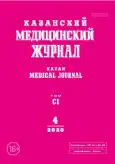Ассоциация экспрессии рSTAT3, рАКТ1 с выживаемостью пациентов с диффузной В-крупноклеточной лимфомой
- Авторы: Ванеева Е.В.1, Росин В.А.1, Дьяконов Д.А.1, Самарина С.В.1
-
Учреждения:
- Кировский научно-исследовательский институт гематологии и переливания крови Федерального медико-биологического агентства
- Выпуск: Том 101, № 4 (2020)
- Страницы: 501-506
- Тип: Теоретическая и клиническая медицина
- URL: https://journal-vniispk.ru/kazanmedj/article/view/33940
- DOI: https://doi.org/10.17816/KMJ2020-501
- ID: 33940
Цитировать
Аннотация
Цель. Оценить связь изолированной и сочетанной экспрессии рSTAT3, рАКТ1 в опухолевых клетках с выживаемостью больных диффузной В-крупноклеточной лимфомой.
Методы. В исследование включены 100 пациентов с впервые диагностированной диффузной В-крупноклеточной лимфомой, находившихся под наблюдением в клинике института с 2010 по 2018 гг. и получавших стандартную полихимиотерапию 1-й линии по схеме R-CHOP. Определение относительного количества экспрессирующих рSTAT3 и рАКТ1 опухолевых клеток проведено с помощью иммуногистохимического и морфометрического методов. С помощью ROC-метода оптимальный порог отсечения экспрессии опухолевых клеток для белка рSTAT3 установили на уровне 68%, для рАКТ1 — 70%. С учётом этих значений всех пациентов с диффузной В-крупноклеточной лимфомой разделили на группы с высокой и низкой степенью экспрессии указанных маркёров. В результате группу с гиперэкспрессией рSTAT3 (≥68% опухолевых клеток) составили 53 пациента, с низкой степенью активности pSTAT3 (<68% опухолевых клеток) — 47 больных. При корреляционном анализе использовали коэффициент корреляции Спирмена. Общую и бессобытийную выживаемость рассчитывали по методу Каплана–Мейера с графическим построением соответствующих кривых. Для подтверждения статистической достоверности полученных данных использовали логранговый критерий.
Результаты. 5-летняя общая выживаемость в группе с гиперэкспрессией рSTAT3 составила 55% — против 87% в группе с низким уровнем экспрессии белка (p=0,015). Значимые различия установлены при оценке бессобытийной выживаемости: 43% — в случаях с высокой экспрессией рSTAT3, 66% — с низкой (p=0,011). Выявлено статистически достоверное значение высокого уровня экспрессии рАКТ1 для 5-летней общей и бессобытийной выживаемости (p <0,001 и p=0,003). При низком уровне экспрессии рАКТ1 общая выживаемость составила 81%, при высоком уровне экспрессии — 43%, бессобытийная — 64 и 41% соответственно. Также было отмечено, что пациенты с сочетанной гиперэкспрессией рАКТ1+/рSTAT3+ характеризовались наиболее низкими показателями общей и бессобытийной выживаемости по сравнению с группой рАКТ1–/рSTAT3– (р=0,001; р <0,001).
Вывод. Биомаркёры рSTAT3 и рАКТ1 могут выступать в качестве дополнительных критериев прогноза при диффузной В-крупноклеточной лимфоме.
Ключевые слова
Полный текст
Открыть статью на сайте журналаОб авторах
Елена Викторовна Ванеева
Кировский научно-исследовательский институт гематологии и переливания крови Федерального медико-биологического агентства
Автор, ответственный за переписку.
Email: vaneeva.elena.vic@mail.ru
Россия, г. Киров, Россия
Виталий Анатольевич Росин
Кировский научно-исследовательский институт гематологии и переливания крови Федерального медико-биологического агентства
Email: vaneeva.elena.vic@mail.ru
Россия, г. Киров, Россия
Дмитрий Андреевич Дьяконов
Кировский научно-исследовательский институт гематологии и переливания крови Федерального медико-биологического агентства
Email: vaneeva.elena.vic@mail.ru
Россия, г. Киров, Россия
Светлана Валерьевна Самарина
Кировский научно-исследовательский институт гематологии и переливания крови Федерального медико-биологического агентства
Email: vaneeva.elena.vic@mail.ru
Россия, г. Киров, Россия
Список литературы
- Поддубная И.В. Диффузная В-клеточная крупноклеточная лимфома. В кн.: Российские клинические рекомендации по диагностике и лечению лимфопролиферативных заболеваний. Под ред. И.В. Поддубной, В.Г. Савченко. М.: ООО «БукиВеди». 2018; 58–65.
- Sehn L.H., Gascoyne R.D. Diffuse large B-cell lymphoma: optimizing outcome in the context of clinical and biologic heterogeneity. Blood. 2015; 125 (1): 22–32. doi: 10.1182/blood-2014-05-577189.
- Расторгуев С.М., Королёва Д.А., Булыгина Е.С. и др. Клиническое и прогностическое значение молекулярных маркёров диффузной В-крупноклеточной лимфомы. Клин. онкогематол. 2019; 12 (1): 95–100. doi: 10.21320/2500-2139-2019-12-1-95-100.
- Капланов К.Д., Волков Н.П., Клиточенко Т.Ю. Результаты анализа регионального регистра пациентов с диффузной В-крупноклеточной лимфомой: факторы риска и проблемы иммунохимиотерапии. Клин. онкогематол. 2019; 12 (2): 154–164. doi: 10.21320/2500-2139-2019-12-2-154-164.
- Ling Dong, Huijuan Lv, Wei Li et al. Co-expression of PD-L1 and p-AKT is associated with poor prognosis in diffuse large B-cell lymphoma via PD-1/PD-L1 axis activating intracellular AKT/mTOR pathway in tumor cells. Oncotarget. 2016; 7 (22): 33 350–33 362. doi: 10.18632/oncotarget.9061.
- Rawlings J.S., Rosler K.M., Harrison D.A. The JAK/STAT signaling pathway. J. Cell Sci. 2004; 117 (8): 1281–1283. doi: 10.1242/jcs.00963.
- Wu Z.L., Song Y.Q., Shi Y.F. et al. High nuclear expressions of STAT3 is associated with unfavorable prognosis in diffuse large B-cell lymphoma. J. Hematol. Oncol. 2011; 4: 31. doi: 10.1186/1756-8722-4-31.
- Xiaoxiao Wang-Xin Cao, Ruifang Sun. Clinical significance of PTEN deletion, mutation, and loss of PTEN expression in de novo diffuse large B-cell lymphoma. Neoplasia. 2018; 20 (6): 574–593. doi: 10.1016/j.neo.2018.03.002.
- Courtney K.D., Corcoran R.B., Engelman J.A. The PI3K pathway as drug target in human cancer. J. Clin. Oncol. 2010; 28: 1075–1083. doi: 10.1200/JCO.2009.25.3641.
- Jinfen Wang, Xu-Monette Z.Y., Jabbar K.J. et al. AKT hyperactivation and the potential of AKT-targeted therapy in diffuse large B-cell lymphoma. Am. J. Pathol. 2017; 187 (8): 1700–1716. doi: 10.1016/j.ajpath.2017.04.009.
- Chi Young Ok, Xu-Monette Z.Y., Tzankov A. et al. STAT3 expression and clinical inplications in de novo diffuse large B cell lymphoma: a report from the International DLBCL Rituximab-CHOP consortium program. Blood. 2013; 121 (20): 4021–4031. doi: 10.1182/blood-2012-10-460063.
Дополнительные файлы











